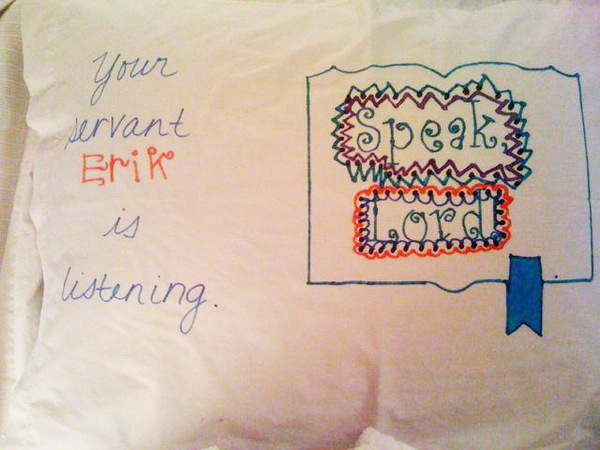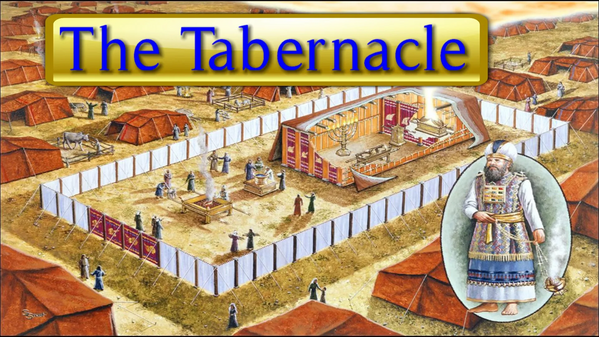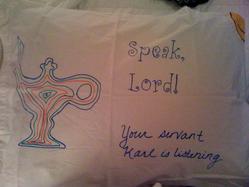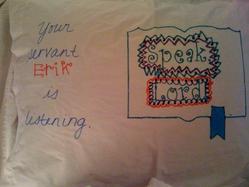Samuel: Listening to God!
Some lessons include the story of Hannah too!
Overview of the Workshops:
- Art: This lesson has been replaced with Anne Camp's decorating Samuel "I'm Listening" pillow cases.
Focus: Listening to God, serving God. - Bible Skills & Games: Children will play several listening games.
Focus: Learning to listen to God. - Cooking: Children will create Samuel’s bed snacks.
Focus: Remembering the story, hearing God’s voice. - Drama: Children will explore the different characters in the story using Frozen Statue techniques.
Focus: Learning about the characters in the story, exploring baptism. - Mission: Children will gather and sort Baby Shower Mission Gifts and make gift cards to go with packages.
Focus: Serving God like Samuel - Video: Children will view the Nest Video “Samuel.”
Focus: Overview of the story. - Music Video Idea for older children/youth added by Neil MacQueen at a later date.
- Samuel: Listening to God Music/Movement Workshop: Blacklight Theater added by Jaymie, at a later date, is found over in the "Music & Other Workshops for Samuel" forum located here.
Scripture References:
I Samuel 1-3
Memory Verse:
“Speak Lord, I’m listening.” I Samuel 3:9
Theme:
God spoke to the people in the Bible. God still speaks to us today through the Bible, through those who love us, through preachers and teachers, through Christian friends, through worship and prayer and experiences.
Background Information:
The books of I and II Samuel explore the history of Israel from the 12th Century to 10th Century B.C. These books describe Israel’s transition from a loosely organized Tribal Confederacy governed by judges to a unified monarchy. Samuel was Israel’s last and greatest judge.
After the death of Moses and the Israelites’ entry into the Promised Land, Israel was governed by judges. Judges were people with great moral character and believed to have a close connection to God. They made God’s will known to the people. Eli was a priest and judge in the town of Shiloh. The Tabernacle had become a more permanent structure, sometimes called a shrine, and was located at Shiloh. Eli served as the priest and cared for the tabernacle. Each year, the Israelites made three required pilgrimages to worship and offer sacrifices at Shiloh.
Hannah and Elakanah
Elkanah (El-KAY-nuh) was from the tribe of Levi. He had two wives – Hannah and Peninnah (Puh – NIN –uh). He greatly loved Hannah, but she was unable to have children. His second wife, Peninnah, had several children. Polygamy in these times was not considered morally wrong, however it was economically unfeasible for many. If a first wife was barren, it was common for men to take additional wives. This seems to have been the case in Elkanah’s situation. Rural families also tended to have more wives to ensure enough children were born to work the fields and because infant and childhood mortality was so high. Children in Bible times were considered to be special blessings from God (still are!). Children were a symbol of fulfillment. In contrast, childlessness in Bible times was considered a great curse and punishment from God. Hannah’s barrenness was a bitter disappointment for her. Peninnah did not help matters by constantly teasing her about her childlessness.
Each year, Elkanah’s family made the pilgrimage from their home in Ramah to Shiloh to worship and offer sacrifices for the forgiveness of their sins at the tabernacle. (The tabernacle by this time was housed at Shiloh and may have been a more permanent building than the portable building used in the wilderness.) Each year, as family members gathered, Hannah was reminded of her childless state. Her bitterness and despair over her childlessness dominated her entire life. Because of her depression, she was unable to see the blessings God had given her, such as a loving husband.
During one of these annual pilgrimages, Hannah fervently prayed for God to give her a child. In return she promised that she would give him to the Lord as a Nazirite. (A Nazirite was one who was under a special vow of separation to the Lord. Nazirites could not cut their hair, touch a dead body or drink any fermented drinks. Samson was probably the most well-known Nazirite. Samuel and John the Baptist were also dedicated similarly.) The dedication of the firstborn son was a common practice for families. However, most families “redeemed” their firstborn by bringing a special sacrifice to the tabernacle or temple. God answered Hannah’s prayer, she became pregnant and baby Samuel was born. The name Samuel means “name of God” or “asked of God.”
The dedication of Samuel
Hannah remembered her promise to God. After he was weaned (probably at about age 3-4), she took him to Eli, the priest at Shiloh, and left him in his care. Hannah’s prayer of joy and praise at Samuel’s dedication is an amazing declaration of faith and understanding of God. In this prayer, Hannah declares God to be holy, the one who sees and judges all human affairs, the one who satisfies our needs and the Master of all that happens to us. Mary’s Magnificat (in Luke 2) is modeled after Hannah’s prayer of thanksgiving in I Samuel 2.
It may be difficult for our children to understand how Hannah could “give away” her son. This did not mean that Hannah stopped loving her son; indeed, we read that each year Hannah and Elkanah journeyed to Shiloh to visit Samuel and bring him a new coat. Young children were often apprenticed to learn various careers. Samuel was groomed to replace Eli since Eli’s own sons were spoiled, unruly young men. It would have been a great honor for a young boy to serve in the tabernacle with the priest. And we also read that God blessed Hannah and Elkanah with three more sons and two daughters. God is able to answer our prayers in greater ways than we can imagine!
Relation to baptism
There are similarities between the practice of infant baptism and Samuel’s dedication to the Lord. In both instances, the parents promise to bring their children up to know and love the Lord. In our Baptismal Covenant, parents promise to nurture their children “in Christ’s holy church, that by (their) teaching and example they may be guided to accept God’s grace for themselves, to profess their faith openly, and to lead a Christian life.” The congregation also promises to “do all in your power to increase their faith, confirm their hope and perfect them in love.” Samuel’s upbringing with Eli would have surrounded him in the ways of God and groomed him for God’s service.
God calls Samuel
One night Samuel heard a voice calling out to him. Thinking it was Eli, he went and woke the old priest. After the third time, Eli finally realized that Samuel was hearing the voice of God and instructed him to say, “Speak Lord, your servant is listening.” Samuel obeyed and God relayed his message. God told Samuel that Eli’s sons would not inherit the priesthood because of their evil ways. They regularly violated the regulations of the Law regarding the sacrifices. They were violent, dishonest and adulterous. While Eli rebuked his sons, he was unwilling to take the discipline further and continued to allow them to serve as priests. Because of this Eli’s sons would lose their positions. Instead, God called Samuel to serve him in a mighty way as a prophet and leader of Israel. Samuel would be the one who would take over after Eli’s death. God continued to lead the Israelites through Samuel for many years.
God calls us
Too often, adults brush children aside. Children are not expected to fully participate in worship or to understand matters of faith. This story makes clear that God speaks to willing hearts – young or old. Children as well as adults are called by God to serve. What are ways our children can listen to and serve God?
How do we hear God’s voice today? Sometimes God still speaks in an audible voice. But we also hear God’s voice through prayer, by listening or reading the Bible, through worship, by listening to sermons or Sunday school teachers, through Christian friends and parents, and through the feelings and experiences God presents us with. Children need to know that God speaks to us very clearly through His Word, the Bible. How do we show God that we are listening to him? By taking time to be still and seeking God’s voice, by talking to God and by doing what God says to do. As we grow in faith, God’s voice becomes more clear in our lives.
Sources:
- New Invitation Bible Studies, Summer 1990, Fall 1995, Graded Press; Bible Zone #6 “Hannah and Samuel” Abingdon Press, 1998; Bible Teacher’s Commentary, Lawrence O. Richards, Cook Communications, 2002; United Methodist Hymnal, United Methodist Publishing House, Nashville, Tennessee, 1989.
A lesson set from State Street UMC Bristol, VA. Updated by the Rotation.org Content Team

 Scripture References:
Scripture References:

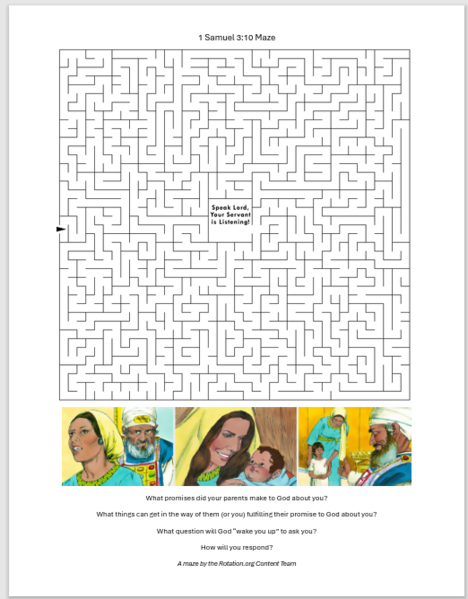
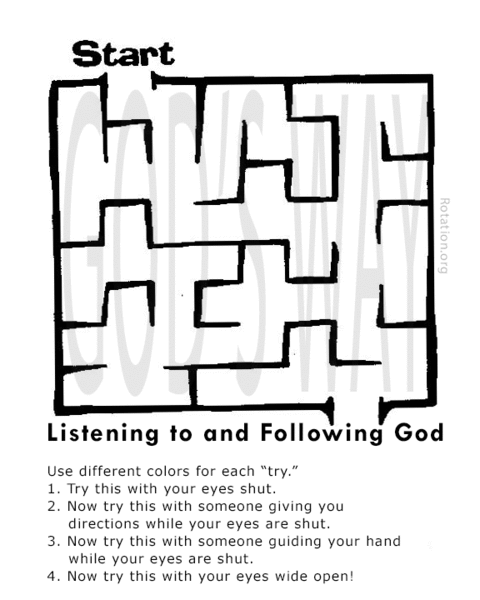


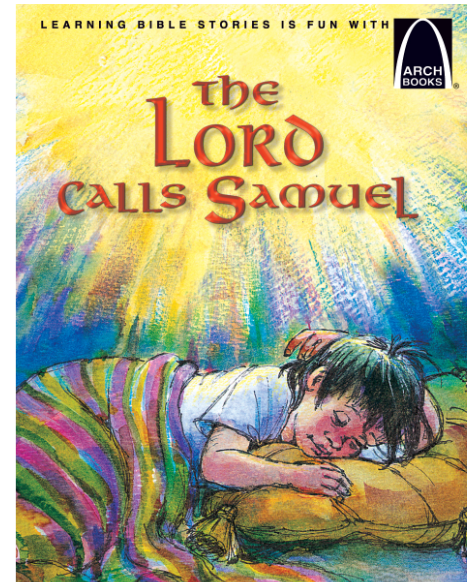

 See the Bible Background for scripture passages and additional information.
See the Bible Background for scripture passages and additional information.